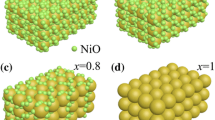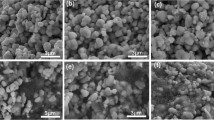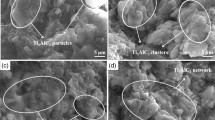Abstract
While metal or carbon materials served as conductive phase in fabricating metamaterials or metacomposites have been widely investigated, MAX phases could provide alternative route. In this paper, Poly(vinylidene fluoride)/Ti3SiC2 MAX phase metacomposites with different Ti3SiC2 content were fabricated. Electrical and dielectric properties of metacomposites were analyzed. Percolating phenomenon was observed over the percolation threshold (fc). Below fc, ac conductivity spectra were explained by Jonscher’s power law, indicating hop** conduction behavior. Above fc, ac conductivity of composites follows Drude model, suggesting the metal-like conductive behavior. Weakly negative permittivity behavior was observed and explained by Lorentz and Drude model, suggesting the combinative contribution of induced electric dipole resonance and low-frequency plasmonic oscillation. The impedance performance of composites were also clarified by Nyquist plots and equivalent circuit analysis, manifesting the capacitive-inductive shift of composites. This work presented a novel route to metacomposites with weakly negative permittivity which greatly benefitted the practical applications of MAX phase in metacomposites.








Similar content being viewed by others
References
D.J. Bergman, D. Stroud, Physical properties of macroscopically inhomogeneous media. Solid State Phys. 46, 147–269 (1992)
D.R. Smith, J.B. Pendry, M.C. Wiltshire, Metamaterials and negative refractive index. Science 305, 788–792 (2004)
B. Wang, K.H. Teo, T. Nishino, W. Yerazunis, J. Barnwell, J. Zhang, Experiments on wireless power transfer with metamaterials. Appl. Phys. Lett. 98, 254101–254103 (2011)
S. Jahani, Z. Jacob, All-dielectric metamaterials. Nat. Nanotechnol. 11, 23–36 (2016)
N.K. Grady, J.E. Heyes, D.R. Chowdhury, Y. Zeng, M.T. Reiten, A.K. Azad, A.J. Taylor, D.A. Dalvit, H.T. Chen, Terahertz metamaterials for linear polarization conversion and anomalous refraction. Science 340, 1304–1307 (2013)
W.J. Padilla, D.N. Basov, D.R. Smith, Negative refractive index metamaterials. Mater. Today 9, 28–35 (2006)
S. Linden, C. Enkrich, M. Wegener, J. Zhou, T. Koschny, C.M. Soukoulis, Magnetic response of metamaterials at 100 terahertz. Science 306, 1351–1353 (2004)
V.M. Shalaev, T.A. Klar, V.P. Drachev, A.V. Kildishev, Optical negative-index metamaterials: from low to no loss. Nat. Photon. 1, 41–48 (2006)
D.R. Smith, J.B. Pendry, M.C.K. Wiltshire, Metamaterials and negative refractive index. Science 305, 788–792 (2004)
X. Zhang, Metamaterials for perpetual cooling at large scales. Science 355, 1023–1024 (2017)
M. Chen, X. Wang, Z. Zhang, K. Sun, C. Cheng, F. Dang, Negative permittivity behavior and magnetic properties of C/YIG composites at radio frequency. Mater. Des. 97, 454–458 (2016)
N.D. Gavrilova, V.K. Novik, A.V. Vorobyev, I.A. Malyshkina, Negative dielectric permittivity of poly(acrylic acid) pressed pellets. J. Non-Cryst. Solids 452, 1–8 (2016)
Z. Zhang, R. Fan, Z. Shi, S. Pan, K. Yan, K. Sun, J. Zhang, X. Liu, X.L. Wang, S.X. Dou, Tunable negative permittivity behavior and conductor–insulator transition in dual composites prepared by selective reduction reaction. J. Mater. Chem. C 1, 79–85 (2013)
Z. Zhang, K. Sun, Y. Liu, Z. Kuang, S. Sun, X. Ji, The negative permittivity behavior and magnetic property of FeNi/Al2O3 composites in radio frequency region. Ceram. Int. 42, 19063–19065 (2016)
M. Chen, R.H. Fan, M. Gao, S.B. Pan, M.X. Yu, Z.D. Zhang, Negative permittivity behavior in Fe50Ni50/Al2O3 magnetic composite near percolation threshold. J. Magn. Magn. Mater. 381, 105–108 (2015)
M. Chen, M. Gao, F. Dang, N. Wang, B. Zhang, S. Pan, Tunable negative permittivity and permeability in FeNiMo/Al2O3 composites prepared by hot-pressing sintering. Ceram. Int. 42, 6444–6449 (2016)
Q. Hou, K.L. Yan, R.H. Fan, Z.D. Zhang, M. Chen, K. Sun, C.B. Cheng, Experimental realization of tunable negative permittivity in percolative Fe78Si9B13/epoxy composites. RSC Adv. 5, 9472–9475 (2015)
X.A. Wang, Z.C. Shi, M. Chen, R.H. Fan, K.L. Yan, K. Sun, S.B. Pan, M.X. Yu, Tunable electromagnetic properties in Co/Al2O3 cermets prepared by wet chemical method. J. Am. Ceram. Soc. 97, 3223–3229 (2014)
M.A. Piechowiak, J. Henon, O. Durand-Panteix, G. Etchegoyen, V. Coudert, P. Marchet, F. Rossignol, Growth of dense Ti3SiC2 MAX phase films elaborated at room temperature by aerosol deposition method. J. Eur. Ceram. Soc. 34, 1063–1072 (2014)
L.L. Zheng, L.C. Sun, M.S. Li, Y.C. Zhou, Improving the high-temperature oxidation resistance of Ti3(SiAl)C2 by Nb-do**. J. Am. Ceram. Soc. 94, 3579–3586 (2011)
J.L. Smialek, Environmental resistance of a Ti2AlC-type MAX phase in a high pressure burner rig. J. Eur. Ceram. Soc. 37, 23–34 (2017)
R. Yin, H. Wu, K. Sun et al., Fabrication of graphene network in alumina ceramics with adjustable negative permittivity by spark plasma sintering. J. Phys. Chem. C 122, 1791–1799 (2018)
R. Yin, Y. Zhang, W. Zhao et al., Graphene platelets/aluminium nitride metacomposites with double percolation property of thermal and electrical conductivity. J. Eur. Ceram. Soc. 38, 4701–4706 (2018)
H. Wu, R. Yin, Y. Zhang et al., Synergistic effects of carbon nanotubes on negative dielectric properties of graphene-phenolic resin composites. J. Phys. Chem. C 121, 12037–12045 (2017)
H. Wu, R. Yin, L. Qian et al., Three-dimensional graphene network/phenolic resin composites towards tunable and weakly negative permittivity. Mater. Des. 117, 18–23 (2017)
H. Wu, Y. Zhang, R. Yin et al., Magnetic negative permittivity with dielectric resonance in random Fe3O4@graphene-phenolic resin composites. Adv. Compos. Hybrid Mater. 1, 168–176 (2018)
H. Wu, Y. Qi, Z. Wang et al., Low percolation threshold in flexible graphene/acrylic polyurethane composites with tunable negative permittivity. Compos. Sci. Technol. 151, 79–84 (2017)
P. **e, Z. Wang, Z. Zhang et al., Silica microspheres templated self-assembly of three-dimensional carbon network with stable radio-frequency negative permittivity and low dielectric loss. J. Mater. Chem. C 6, 5239–5249 (2018)
P. **e, K. Sun, Z. Wang et al., Negative permittivity adjusted by SiO2-coated metallic particles in percolative composites. J. Alloy. Compd. 725, 1259–1263 (2017)
Z. Guo, P. **e, F. Dang et al., Bio-gel derived nickel/carbon nanocomposites with enhanced microwave absorption. J. Mater. Chem. C 6, 8812–8822 (2018)
P. **e, W. Sun, Y. Liu et al., Carbon aerogels towards new candidates for double negative metamaterials of low density. Carbon 129, 598–606 (2018)
Z. Zhao, R. Guan, J. Zhang, Z. Zhao, P. Bai, Effects of process parameters of semisolid stirring on microstructure of Mg-3Sn-1Mn-3SiC (wt%) strip processed by rheo-rolling. Acta Metall. Sin. 30, 66–72 (2017)
Z. Zhao, P. Bai, R. Guan, V. Murugadoss, H. Liu, X. Wang, Z. Guo, Microstructural evolution and mechanical strengthening mechanism of Mg-3Sn-1Mn-1La alloy after heat treatments. Mater. Sci. Eng. A 734, 200–209 (2018)
T. Su, Q. Shao, Z. Qin, Z. Guo, Z. Wu, Role of interfaces in two-dimensional photocatalyst for water splitting. ACS Catal. 8, 2253–2276 (2018)
Z. Sun et al., Experimental and simulation understanding of morphology controlled barium titanate nanoparticles under co-adsorption of surfactants. CrystEngComm 19, 3288–3298 (2017)
L. Zhang, W. Yu, C. Han, J. Guo, Q. Zhang, H. **e, Q. Shao, Z. Sun, Z. Guo, Large scaled synthesis of heterostructured electrospun TiO2/SnO2 nanofibers with an enhanced photocatalytic activity. J. Electrochem. Soc. 164, H651–H656 (2017)
L. Zhang, M. Qin, W. Yu, Q. Zhang, H. **e, Z. Sun, Q. Shao, X. Guo, L. Hao, Y. Zheng, Z. Guo, Heterostructured TiO2/WO3 nanocomposites for photocatalytic degradation of toluene under visible light. J. Electrochem. Soc. 164, H1086–H1090 (2017)
Y. Zhang, L. Qian, W. Zhao, X. Li, X. Huang, X. Mai, Z. Wang, Q. Shao, X. Yan, Z. Guo, Highly efficient Fe-N-C nanoparticles modified porous graphene composites for oxygen reduction reaction. J. Electrochem. Soc. 165, H510–H516 (2018)
B. Song, T. Wang, H. Sun, Q. Shao, J. Zhao, K. Song, L. Hao, L. Wang, Z. Guo, Two-step hydrothermally synthesized carbon nanodots/WO3 photocatalysts with enhanced photocatalytic performance. Dalton Trans. 46, 15769–15777 (2017)
X. Lou, C. Lin, Q. Luo, J. Zhao, B. Wang, J. Li, Q. Shao, X. Guo, N. Wang, Z. Guo, Crystal-structure modification enhanced FeNb11O29 anodes for lithium-ion batteries. ChemElectroChem 4, 3171–3180 (2017)
C. Lin, H. Hu, C. Cheng, K. Sun, X. Guo, Q. Shao, J. Li, N. Wang, Z. Guo, Nano-TiNb2O7/carbon nanotubes composite anode for enhanced lithium-ion storage. Electrochim. Acta 260, 65–72 (2018)
Q. Hou, J. Ren, H. Chen, P. Yang, Q. Shao, M. Zhao, X. Zhao, H. He, N. Wang, Q. Luo, Z. Guo, Synergistic hematite-fullerene electron extracting layers for improved efficiency and stability in perovskite solar cells. ChemElectroChem 5, 726–731 (2018)
Y. Li, T. **g, G. Xu, J. Tian, M. Dong, Q. Shao, B. Wang, Z. Wang, Y. Zheng, C. Yang, Z. Guo, 3-D magnetic graphene oxide-magnetite poly(vinyl alcohol) nanocomposite substrates for immobilizing enzyme. Polymer 149, 13–22 (2018)
C. Wang, M. Zhao, J. Li, J. Yu, S. Sun, S. Ge, X. Guo, F. **e, B. Jiang, E. Wujcik, Y. Huang, N. Wang, Z. Guo, Silver nanoparticles/graphene oxide decorated carbon fiber synergistic reinforcement in epoxy-based composites. Polymer 131, 263–271 (2017)
J. Zhao, L. Wu, C. Zhan, Q. Shao, Z. Guo, L. Zhang, Overview of polymer nanocomposites: computer simulation understanding of physical properties. Polymer 133, 272–287 (2017)
X. Cui, G. Zhu, Y. Pan, Q. Shao, C. Zhao, M. Dong, Y. Zhang, Z. Guo, Polydimethylsiloxane-titania nanocomposite coating: fabrication and corrosion resistance. Polymer 138, 203–210 (2018)
C. Wang, B. Mo, Z. He, C.X. Zhao, L. Zhang, Q. Shao, X. Guo, E. Wujcik, Z. Guo, Hydroxide ions transportation in polynorbornene anion exchange membrane. Polymer 138, 363–368 (2018)
Y. He, S. Yang, H. Liu et al., Reinforced carbon fiber laminates with oriented carbon nanotube epoxy nanocomposites: magnetic field assisted alignment and cryogenic temperature mechanical properties. J. Colloid Interface Sci. 517, 40–51 (2018)
Z. Wu, S. Gao, L. Chen, D. Jiang, Q. Shao, B. Zhang, Z. Zhai, C. Wang, M. Zhao, Y. Ma, X. Zhang, L. Weng, M. Zhang, Z. Guo, Electrically insulated epoxy nanocomposites reinforced with synergistic core-shell SiO2@MWCNTs and montmorillonite bifillers. Macromol. Chem. Phys. 218, 1700357 (2017)
Y. Zheng, Y. Zheng, S. Yang, Z. Guo, T. Zhang, H. Song, Q. Shao, Esterification synthesis of ethyl oleate catalyzed by Brønsted acid-surfactant-combined ionic liquid. Green Chem. Lett. Rev. 10, 202 (2017)
Y. Zheng, Y. Zheng, Z. Wang, Y. Cao, Q. Shao, Z. Guo, Sodium dodecyl benzene sulfonate-catalyzed reaction for aromatic aldehydes with 1-phenyl-3-methyl-5-pyrazolone in aqueous media. Green Chem. Lett. Rev. 11, 217–223 (2018)
Acknowledgements
This study was financially supported by the National Natural Science Foundation of China [Grant Nos. 51771104 and 51402170].The author Yunpeng Qu thanks Murakami Haruki, Franz Kafka and Higashino Keigo whose novels comforted the author’s soul. The author Yunpeng Qu also thanks Prof. Shaohua Lin from Ocean University of China (OUC) whose replying letter encouraged Qu to work for the graduate degree.
Author information
Authors and Affiliations
Corresponding authors
Electronic supplementary material
Below is the link to the electronic supplementary material.
Rights and permissions
About this article
Cite this article
Liu, Y., Qu, Y., **n, J. et al. Weakly Radio-Frequency Negative Permittivity of Poly(vinylidene fluoride)/Ti3SiC2 MAX Phase Metacomposites. J Inorg Organomet Polym 29, 248–257 (2019). https://doi.org/10.1007/s10904-018-0983-8
Received:
Accepted:
Published:
Issue Date:
DOI: https://doi.org/10.1007/s10904-018-0983-8




